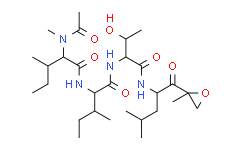| Cas No.: | 134381-21-8 |
| Chemical Name: | L-Threoninamide,N-acetyl-N-methyl-L-isoleucyl-L-isoleucyl-N-[(1S)-3-methyl-1-[[(2R)-2-methyl-2-oxiranyl]carbonyl]butyl]- |
| Synonyms: | L-Threoninamide,N-acetyl-N-methyl-L-isoleucyl-L-isoleucyl-N-[(1S)-3-methyl-1-[[(2R)-2-methyl-2-oxiranyl]carbonyl]butyl]-;(2S,3S)-2-[[(2S,3S)-2-[acetyl(methyl)amino]-3-methylpentanoyl]amino]-N-[(2S,3R)-3-hydroxy-2-[[(2S)-4-methyl-1-[(2R)-2-methyloxiran-2-yl]-1-oxopentan-2-yl]amino]butanoyl]-3-methylpentanamide;BU-4061T;Epoxomicin;Epoxomicin (BU 4061T, BU-4061T);Epoxomicin (BU-4061T);S7038,BU-4061T;N-Acetyl-N-methyl-L-isoleucyl-L-isoleucyl-N-[(1S)-3-methyl-1-[[(2R)-2-methyl-2-oxiranyl]carbonyl]butyl]-L-threoninamide;BU 4061T |
| SMILES: | CCC(C)C(NC(=O)C(C(C)CC)N(C)C(C)=O)C(=O)NC(C(C)O)C(=O)NC(CC(C)C)C(=O)C1(C)OC1 |
| Formula: | C28H50N4O7 |
| M.Wt: | 554.7192 |
| Purity: | >98% |
| Sotrage: | 2 years -20°C Powder, 2 weeks 4°C in DMSO, 6 months -80°C in DMSO |
| Description: | Epoxomicin is a cell-permeable and irreversible proteasome inhibitor, primarily the chymotrypsin-like activity. |
| References: | [1]. Kim KB, et al. Proteasome inhibition by the natural products epoxomicin and dihydroeponemycin: insights into specificity and potency. Bioorg Med Chem Lett. 1999 Dec 6;9(23):3335-40. [2]. Hanada M, et al. Epoxomicin, a new antitumor agent of microbial origin. J Antibiot (Tokyo). 1992 Nov;45(11):1746-52. [3]. Garrett IR, et al. Selective inhibitors of the osteoblast proteasome stimulate bone formation in vivo and in vitro. J Clin Invest. 2003 Jun;111(11):1771-82. [4]. McNaught KS, et al. Systemic exposure to proteasome inhibitors causes a progressive model of Parkinson's disease. Ann Neurol. 2004 Jul;56(1):149-62. [5]. Rideout HJ, et al. Dopaminergic neurons in rat ventral midbrain cultures undergo selective apoptosis and form inclusions, but do not up-regulate iHSP70, following proteasomal inhibition. J Neurochem. 2005 Jun;93(5):1304-13. |

 To enhance service speed and avoid tariff delays, we've opened a US warehouse. All US orders ship directly from our US facility.
To enhance service speed and avoid tariff delays, we've opened a US warehouse. All US orders ship directly from our US facility.




















